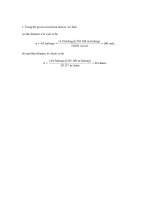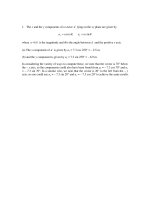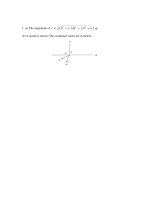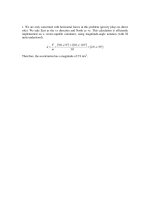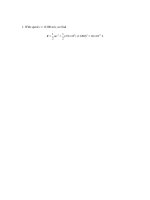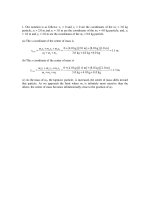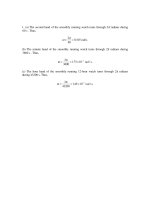Solution manual fundamentals of physics extended, 8th editionch14
Bạn đang xem bản rút gọn của tài liệu. Xem và tải ngay bản đầy đủ của tài liệu tại đây (802.76 KB, 99 trang )
1. The air inside pushes outward with a force given by piA, where pi is the pressure inside
the room and A is the area of the window. Similarly, the air on the outside pushes inward
with a force given by poA, where po is the pressure outside. The magnitude of the net
force is F = (pi – po)A. Since 1 atm = 1.013 × 105 Pa,
F = (1.0 atm − 0.96 atm)(1.013 ×105 Pa/atm)(3.4 m)(2.1 m) = 2.9 × 104 N.
2. We note that the container is cylindrical, the important aspect of this being that it has a
uniform cross-section (as viewed from above); this allows us to relate the pressure at the
bottom simply to the total weight of the liquids. Using the fact that 1L = 1000 cm3, we
find the weight of the first liquid to be
W1 = m1 g = ρ1V1 g
= (2.6 g / cm3 )(0.50 L)(1000 cm3 / L)(980 cm/s 2 ) = 1.27 × 106 g ⋅ cm/s 2 = 12.7 N.
In the last step, we have converted grams to kilograms and centimeters to meters.
Similarly, for the second and the third liquids, we have
W2 = m2 g = ρ 2V2 g = (1.0 g/cm3 )(0.25 L)(1000 cm3 L )(980 cm s 2 ) = 2.5 N
and
W3 = m3 g = ρ3V3 g = (0.80 g/cm3 )(0.40 L)(1000 cm3 / L)(980 cm/s 2 ) = 3.1 N.
The total force on the bottom of the container is therefore F = W1 + W2 + W3 = 18 N.
3. The pressure increase is the applied force divided by the area: ∆p = F/A = F/πr2, where
r is the radius of the piston. Thus ∆p = (42 N)/π(0.011 m)2 = 1.1 × 105 Pa. This is
equivalent to 1.1 atm.
4. The magnitude F of the force required to pull the lid off is F = (po – pi)A, where po is
the pressure outside the box, pi is the pressure inside, and A is the area of the lid.
Recalling that 1N/m2 = 1 Pa, we obtain
pi = po −
F
480 N
= 1.0 × 105 Pa −
= 3.8 × 104 Pa.
A
77 ×10 −4 m 2
5. Let the volume of the expanded air sacs be Va and that of the fish with its air sacs
collapsed be V. Then
ρ fish =
mfish
= 1.08 g/cm3
V
and
ρw =
mfish
= 1.00 g/cm 3
V + Va
where ρw is the density of the water. This implies ρfishV = ρw(V + Va) or (V + Va)/V =
1.08/1.00, which gives Va/(V + Va) = 7.4%.
6. Knowing the standard air pressure value in several units allows us to set up a variety of
conversion factors:
§ 1.01× 105 Pa ·
(a) P = 28 lb/in.2 ¨
= 190 kPa
2 ¸
© 14.7 lb/in ¹
(
)
§ 1.01× 105 Pa ·
(b) (120 mmHg) ¨
¸ = 15.9 kPa,
© 760 mmHg ¹
§ 1.01× 105 Pa ·
(80 mmHg) ¨
¸ = 10.6 kPa.
© 760 mmHg ¹
7. (a) The pressure difference results in forces applied as shown in the figure. We
consider a team of horses pulling to the right. To pull the sphere apart, the team must
exert a force at least as great as the horizontal component of the total force determined by
“summing” (actually, integrating) these force vectors.
We consider a force vector at angle θ. Its leftward component is ∆p cos θdA, where dA is
the area element for where the force is applied. We make use of the symmetry of the
problem and let dA be that of a ring of constant θ on the surface. The radius of the ring is
r = R sin θ, where R is the radius of the sphere. If the angular width of the ring is dθ, in
radians, then its width is R dθ and its area is dA = 2πR2 sin θ dθ. Thus the net horizontal
component of the force of the air is given by
Fh = 2π R 2 ∆p
³
π2
0
sin θ c os θ dθ = π R 2 ∆p sin 2 θ
π /2
0
= π R 2 ∆p.
(b) We use 1 atm = 1.01 × 105 Pa to show that ∆p = 0.90 atm = 9.09 × 104 Pa. The sphere
radius is R = 0.30 m, so
Fh = π(0.30 m)2(9.09 × 104 Pa) = 2.6 × 104 N.
(c) One team of horses could be used if one half of the sphere is attached to a sturdy wall.
The force of the wall on the sphere would balance the force of the horses.
8. Note that 0.05 atm equals 5065 N/m2. Application of Eq. 14-7 with the notation in this
problem leads to
dmax =
5065
ρliquid g
with SI units understood. Thus the difference of this quantity between fresh water (998
kg/m3) and Dead Sea water (1500 kg/m3) is
5065§ 1
1 ·
∆dmax = 9.8 ¨998 - 1500¸ = 0.17 m .
©
¹
9. We estimate the pressure difference (specifically due to hydrostatic effects) as follows:
∆p = ρ gh = (1.06 × 103 kg/m3 )(9.8 m/s 2 )(1.83 m) = 1.90 × 104 Pa.
10. Recalling that 1 atm = 1.01 × 105 Pa, Eq. 14-8 leads to
1 atm
·
≈ 1.08 × 103 atm.
5
¸
© 1.01 × 10 Pa ¹
§
ρ gh = (1024 kg/m 3 ) (9.80 m/s 2 ) (10.9 × 103 m) ¨
11. The pressure p at the depth d of the hatch cover is p0 + ρgd, where ρ is the density of
ocean water and p0 is atmospheric pressure. The downward force of the water on the
hatch cover is (p0 + ρgd)A, where A is the area of the cover. If the air in the submarine is
at atmospheric pressure then it exerts an upward force of p0A. The minimum force that
must be applied by the crew to open the cover has magnitude
F = (p0 + ρgd)A – p0A = ρgdA = (1024 kg/m3)(9.8 m/s2)(100 m)(1.2 m)(0.60 m)
= 7.2 × 105 N.
12. In this case, Bernoulli’s equation reduces to Eq. 14-10. Thus,
pg = ρ g (−h) = − (1800 kg/m3 ) (9.8 m/s 2 ) (1.5 m) = − 2.6 × 104 Pa .
13. With A = 0.000500 m2 and F = pA (with p given by Eq. 14-9), then we have ρghA =
9.80 N. This gives h ≈ 2.0 m, which means d + h = 2.80 m.
14. Since the pressure (caused by liquid) at the bottom of the barrel is doubled due to the
presence of the narrow tube, so is the hydrostatic force. The ratio is therefore equal to 2.0.
The difference between the hydrostatic force and the weight is accounted for by the
additional upward force exerted by water on the top of the barrel due to the increased
pressure introduced by the water in the tube.
15. When the levels are the same the height of the liquid is h = (h1 + h2)/2, where h1 and
h2 are the original heights. Suppose h1 is greater than h2. The final situation can then be
achieved by taking liquid with volume A(h1 – h) and mass ρA(h1 – h), in the first vessel,
and lowering it a distance h – h2. The work done by the force of gravity is
W = ρA(h1 – h)g(h – h2).
We substitute h = (h1 + h2)/2 to obtain
1
1
2
ρ gA ( h1 − h2 ) = (1.30 ×103 kg/m 3 )(9.80 m/s 2 )(4.00 × 10−4 m 2 )(1.56 m − 0.854 m)2
.
4
4
= 0.635 J
W=
16. Letting pa = pb, we find
ρcg(6.0 km + 32 km + D) + ρm(y – D) = ρcg(32 km) + ρmy
and obtain
( 6.0 km ) ρ c
D=
ρ m − ρc
=
( 6.0 km ) ( 2.9 g
cm3
)
3.3g cm3 − 2.9 g cm 3
= 44 km.
17. We can integrate the pressure (which varies linearly with depth according to Eq. 14-7)
over the area of the wall to find out the net force on it, and the result turns out fairly
intuitive (because of that linear dependence): the force is the “average” water pressure
multiplied by the area of the wall (or at least the part of the wall that is exposed to the
1
water), where “average” pressure is taken to mean 2 (pressure at surface + pressure at
bottom). Assuming the pressure at the surface can be taken to be zero (in the gauge
1
pressure sense explained in section 14-4), then this means the force on the wall is 2 ρgh
multiplied by the appropriate area. In this problem the area is hw (where w is the 8.00 m
1
width), so the force is 2 ρgh2w, and the change in force (as h is changed) is
1
ρgw
2
2
2
( hf – hi ) =
1
(998
2
2
2
kg/m3)(9.80 m/s2)(8.00 m)(4.00 – 2.00 )m2 = 4.69 × 105 N.
18. (a) The force on face A of area AA due to the water pressure alone is
(
)(
)
FA = p A AA = ρ w ghA AA = ρ w g (2d )d 2 = 2 1.0 × 103 kg m3 9.8 m s 2 ( 5.0 m )
3
= 2.5 × 106 N.
Adding the contribution from the atmospheric pressure, F0= (1.0 × 105 Pa)(5.0 m)2 =
2.5 × 106 N, we have
FA ' = F0 + FA = 2.5 × 106 N + 2.5 × 106 N = 5.0 × 106 N.
(b) The force on face B due to water pressure alone is
5
5
3
§ 5d ·
FB = pavgB AB = ρω g ¨ ¸ d 2 = ρ w gd 3 = (1.0 ×103 kg m3 )( 9.8 m s 2 ) ( 5.0 m )
2
2
© 2 ¹
6
= 3.1×10 N.
Adding the contribution from the atmospheric pressure, F0= (1.0 × 105 Pa)(5.0 m)2 =
2.5 × 106 N, we have
FB ' = F0 + FB = 2.5 × 106 N + 3.1× 106 N = 5.6 ×106 N.
19. (a) At depth y the gauge pressure of the water is p = ρgy, where ρ is the density of the
water. We consider a horizontal strip of width W at depth y, with (vertical) thickness dy,
across the dam. Its area is dA = W dy and the force it exerts on the dam is dF = p dA =
ρgyW dy. The total force of the water on the dam is
F =
=
³
D
0
ρ gyW dy =
1
ρ gWD 2
2
(
)(
)
1
2
1.00 × 103 kg m3 9.80 m s 2 ( 314 m )( 35.0 m ) = 1.88 ×109 N.
2
(b) Again we consider the strip of water at depth y. Its moment arm for the torque it
exerts about O is D – y so the torque it exerts is dτ = dF(D – y) = ρgyW (D – y)dy and the
total torque of the water is
τ =
=
³
D
0
§1
©2
1
3
·
¹
1
6
ρ gyW ( D − y ) dy = ρ gW ¨ D3 − D 3 ¸ = ρ gWD 3
1
3
1.00 ×103 kg m3 )( 9.80 m s 2 ) ( 314 m )( 35.0 m ) = 2.20 ×1010 N ⋅ m.
(
6
(c) We write τ = rF, where r is the effective moment arm. Then,
r=
τ
F
=
1
6
1
2
ρ gWD 3 D 35.0 m
= =
= 11.7 m.
ρ gWD 2 3
3
20. The gauge pressure you can produce is
(1000 kg
p = − ρ gh = −
)(
)(
m3 9.8 m s 2 4.0 × 10−2 m
1.01×10 Pa atm
5
) = −3.9 ×10
−3
atm
where the minus sign indicates that the pressure inside your lung is less than the outside
pressure.
21. (a) We use the expression for the variation of pressure with height in an
incompressible fluid: p2 = p1 – ρg(y2 – y1). We take y1 to be at the surface of Earth, where
the pressure is p1 = 1.01 × 105 Pa, and y2 to be at the top of the atmosphere, where the
pressure is p2 = 0. For this calculation, we take the density to be uniformly 1.3 kg/m3.
Then,
y2 − y1 =
p1
1.01 × 105 Pa
=
= 7.9 × 103 m = 7.9 km .
3
2
ρ g (1.3 kg/m ) (9.8 m/s )
(b) Let h be the height of the atmosphere. Now, since the density varies with altitude, we
integrate
p2 = p1 −
³
h
0
ρ g dy .
Assuming ρ = ρ0 (1 - y/h), where ρ0 is the density at Earth’s surface and g = 9.8 m/s2 for
0 ≤ y ≤ h, the integral becomes
p2 = p1 −
³
h
0
§
©
ρ0 g ¨1 −
y·
1
¸ dy = p1 − ρ0 gh.
h¹
2
Since p2 = 0, this implies
h=
2 p1
2(1.01 × 105 Pa)
=
= 16 × 103 m = 16 km.
ρ0 g (1.3 kg/m3 ) (9.8 m/s 2 )
22. (a) According to Pascal’s principle F/A = f/a → F = (A/a)f.
(b) We obtain
a
(3.80 cm) 2
f = F =
(20.0 × 103 N) = 103 N.
2
(53.0 cm)
A
The ratio of the squares of diameters is equivalent to the ratio of the areas. We also note
that the area units cancel.
23. Eq. 14-13 combined with Eq. 5-8 and Eq. 7-21 (in absolute value) gives
mg = kx
A1
.
A2
With A2 = 18A1 (and the other values given in the problem) we find m = 8.50 kg.
24. (a) Archimedes’ principle makes it clear that a body, in order to float, displaces an
amount of the liquid which corresponds to the weight of the body. The problem
(indirectly) tells us that the weight of the boat is W = 35.6 kN. In salt water of density
ρ' = 1100 kg/m3, it must displace an amount of liquid having weight equal to 35.6 kN.
(b) The displaced volume of salt water is equal to
V'=
W
3.56 ×103 N
=
= 3.30 m3 .
ρ ' g (1.10 ×103 kg/m3 ) (9.80 m/s2 )
In freshwater, it displaces a volume of V = W/ρg = 3.63 m3, where ρ = 1000 kg/m3. The
difference is V – V ' = 0.330 m3.
25. (a) The anchor is completely submerged in water of density ρw. Its effective weight is
Weff = W – ρw gV, where W is its actual weight (mg). Thus,
V =
W − Weff
200 N
=
= 2.04 × 10−2 m3 .
3
2
ρw g
(1000 kg/m ) ( 9.8 m/s )
(b) The mass of the anchor is m = ρV, where ρ is the density of iron (found in Table
14-1). Its weight in air is
W = mg = ρVg = ( 7870 kg/m 3 ) (2.04 × 10 −2 m3 ) ( 9.80 m/s 2 ) = 1.57 × 103 N .
